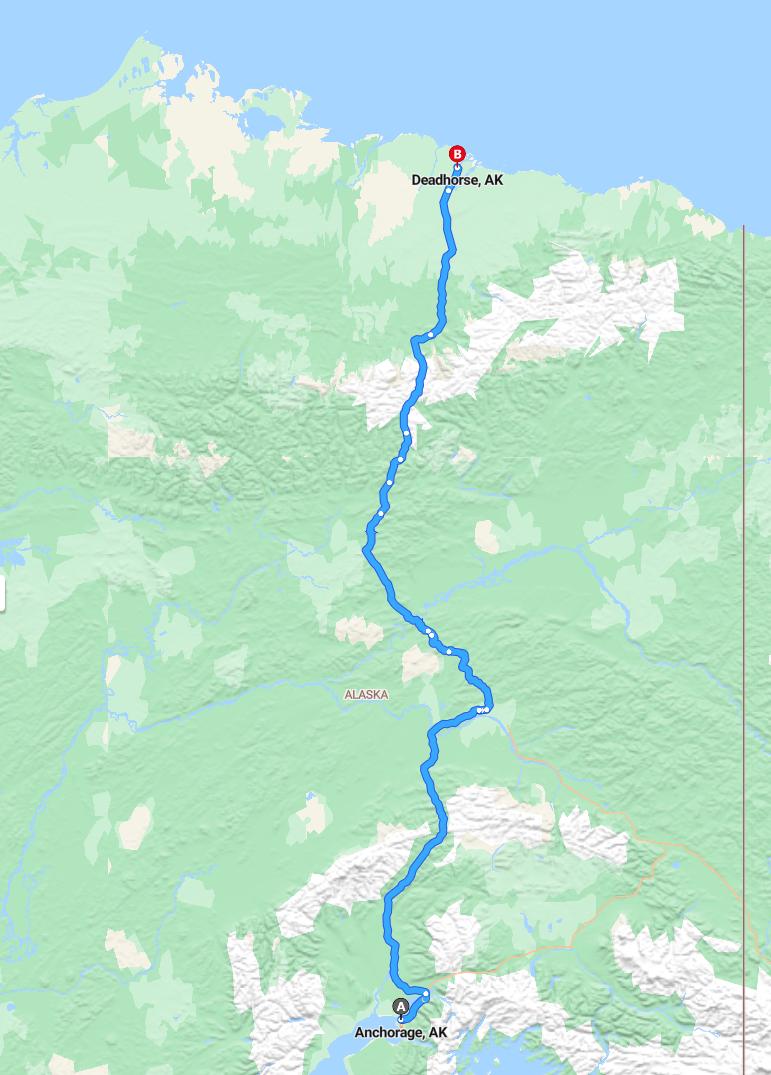Distance and estimated driving time
The journey from Anchorage to Deadhorse covers approximately 852 miles, primarily via AK-3 and AK-11. This drive is estimated to take around 16 hours and 45 minutes, making it a lengthy yet scenic adventure through Alaska's remote landscapes. Travelers should prepare for varying weather conditions and ensure their vehicle is well-maintained for the rugged terrain. Proper planning, including rest stops and fuel management, is essential for a safe and enjoyable trip on this challenging route.
Driving route
Traveling from Anchorage to Deadhorse offers a unique journey through the stunning landscapes of northern Alaska. Starting in Anchorage, the largest city in the state, travelers can experience urban amenities before heading northbound. Along the route, Prudhoe Bay emerges as a notable nearby area, known for its significant oil fields and arctic environment. Continuing the drive, the final destination, Deadhorse, serves as a hub for those exploring the Arctic and the Prudhoe Bay oil fields. This scenic route showcases the diverse Arctic wilderness and provides an adventurous experience through some of Alaska's most remote regions.

Road conditions and seasonal considerations
The drive from Anchorage to Deadhorse traverses remote, rugged terrain with varying road conditions that are heavily influenced by seasonal weather, particularly in winter months. During winter, icy and snow-covered roads pose significant challenges, requiring careful driving and specialized equipment, while summer months generally offer clearer paths with potential for muddy or soft surfaces. Limited services and sparse infrastructure along the route demand thorough planning and vehicle readiness to ensure safety. Travelers should stay informed about weather forecasts and road advisories to navigate this remote journey safely throughout the year.
Vehicle preparation and safety tips
Before embarking on the long drive from Anchorage to Deadhorse, it's essential to ensure your vehicle is thoroughly prepared for the harsh Arctic conditions. Conduct a comprehensive check of the coolant, tires, brakes, and ensure your spare tire and emergency supplies are in good condition. It is also advisable to carry extra fuel, warm clothing, and emergency kits due to the remote nature of the route passing Prudhoe Bay and Deadhorse. Additionally, driving cautiously and staying informed about weather updates help enhance safety during this challenging journey through northern Alaska.
Essential travel supplies and gear
When embarking on a journey from Anchorage to Deadhorse, it is crucial to carry essential travel supplies and gear to ensure safety and comfort. Fundamental items include warm clothing suitable for extreme cold temperatures, waterproof gear, and sturdy footwear to navigate icy and rugged terrains. Additionally, travelers should bring sufficient food, water, and emergency supplies such as a first aid kit, flashlight, and extra batteries. Reliable navigation tools, like GPS devices and maps, along with communication equipment, are also vital for a remote route passing through Prudhoe Bay and other isolated areas.
Permits and regulations for Arctic travel
Traveling from Anchorage to Deadhorse in the Arctic requires careful preparation regarding permits and regulations. Visitors must obtain necessary park permits if traveling through protected areas or engaging in activities like camping or scientific research. Additionally, travelers should familiarize themselves with Arctic-specific safety protocols, environmental guidelines, and transportation regulations to ensure compliance and promote responsible tourism. Proper planning and adherence to these regulations are essential for a safe and sustainable journey through this sensitive and remote region.
Navigation tools and tips for remote areas
When navigating through remote areas like the drive from Anchorage to Deadhorse, it is essential to rely on reliable GPS devices and detailed maps due to limited cell service. Before embarking on the journey, ensure your navigation tools are updated and fully functional to avoid getting lost in vast, featureless landscapes such as Prudhoe Bay and Deadhorse. Carrying extra batteries, portable chargers, and physical maps can provide vital backup in areas with sparse connectivity. Additionally, informing someone about your travel plan and estimated arrival time enhances safety in these remote regions, where navigation errors can lead to prolonged isolation.
Weather forecasts and climate considerations
Traveling from Anchorage to Deadhorse requires careful attention to weather forecasts and climate considerations, as conditions can vary dramatically across this remote route. The region experiences extreme cold temperatures, especially during winter months, with the potential for snowstorms and icy roads that can impact safety and travel plans. It is essential to monitor real-time weather updates before and during the journey, as sudden weather changes may lead to road closures or hazardous driving conditions. Preparation for these harsh climatic conditions, including appropriate vehicle equipment and emergency supplies, is crucial for a safe trip through this Arctic environment.
Wildlife awareness and safety precautions
Traveling from Anchorage to Deadhorse, travelers should remain vigilant about local wildlife, particularly in Prudhoe Bay and surrounding areas, where animals such as bears, caribou, and Arctic foxes may be encountered. It is essential to follow safety precautions, including keeping windows closed, avoiding feeding wildlife, and maintaining a safe distance if animals are sighted. Preparation with appropriate supplies and awareness of wildlife behavior can help prevent dangerous encounters. Prioritizing safety and respecting wildlife habitats are crucial for a secure and environmentally responsible journey through this remote region.
Accommodation options along the route
Travelers driving from Anchorage to Deadhorse have limited accommodation options along this remote route. In Anchorage, a variety of hotels and inns offer comfortable stays before beginning the journey. Near Prudhoe Bay and Deadhorse, accommodations are more sparse, primarily consisting of rugged lodges, basic accommodations, and specialized expeditions facilities designed for adventurers and workers in the area. Due to the remote nature of the route, it is essential for travelers to plan and book accommodations in advance to ensure a safe and comfortable trip.
